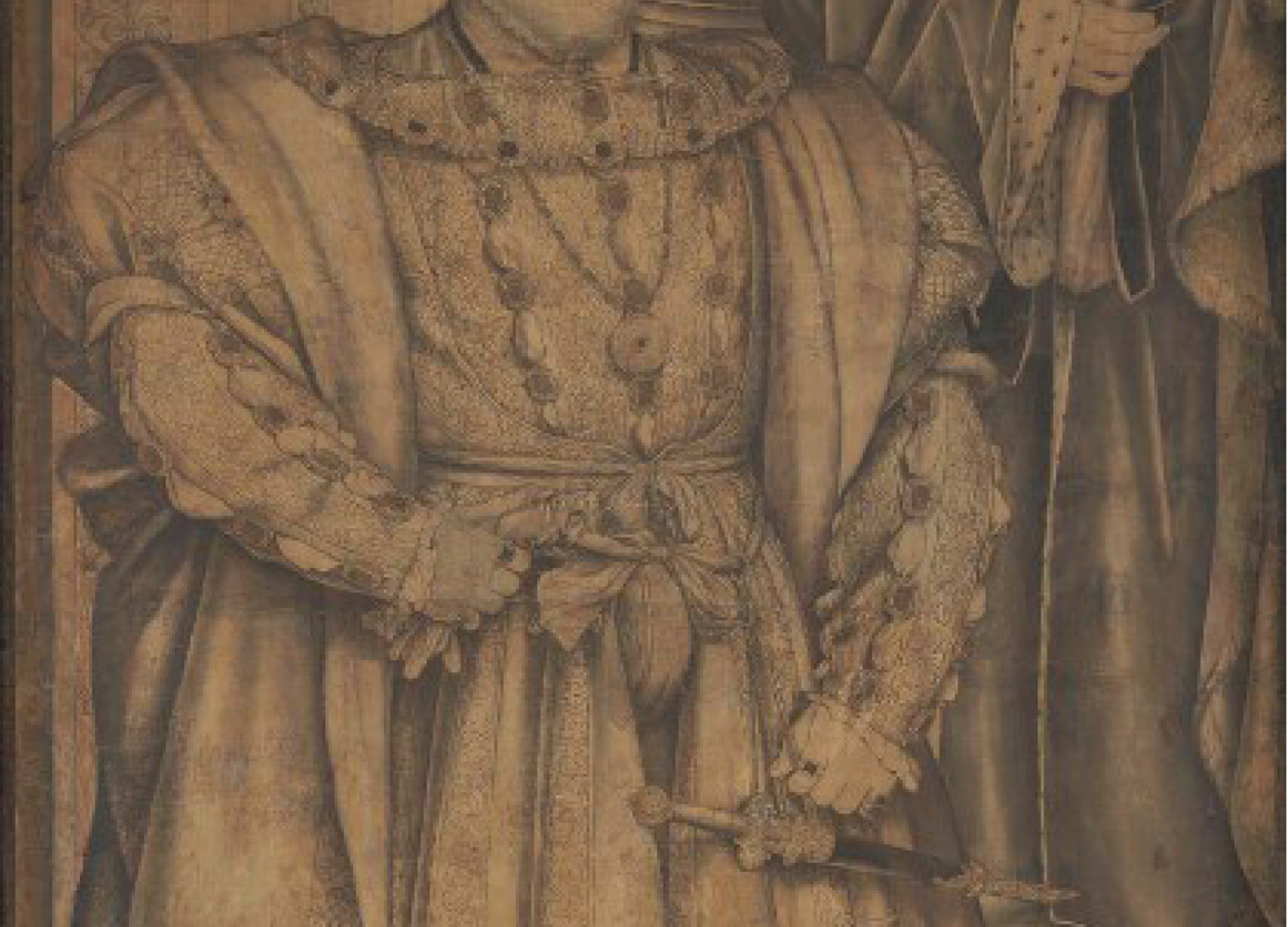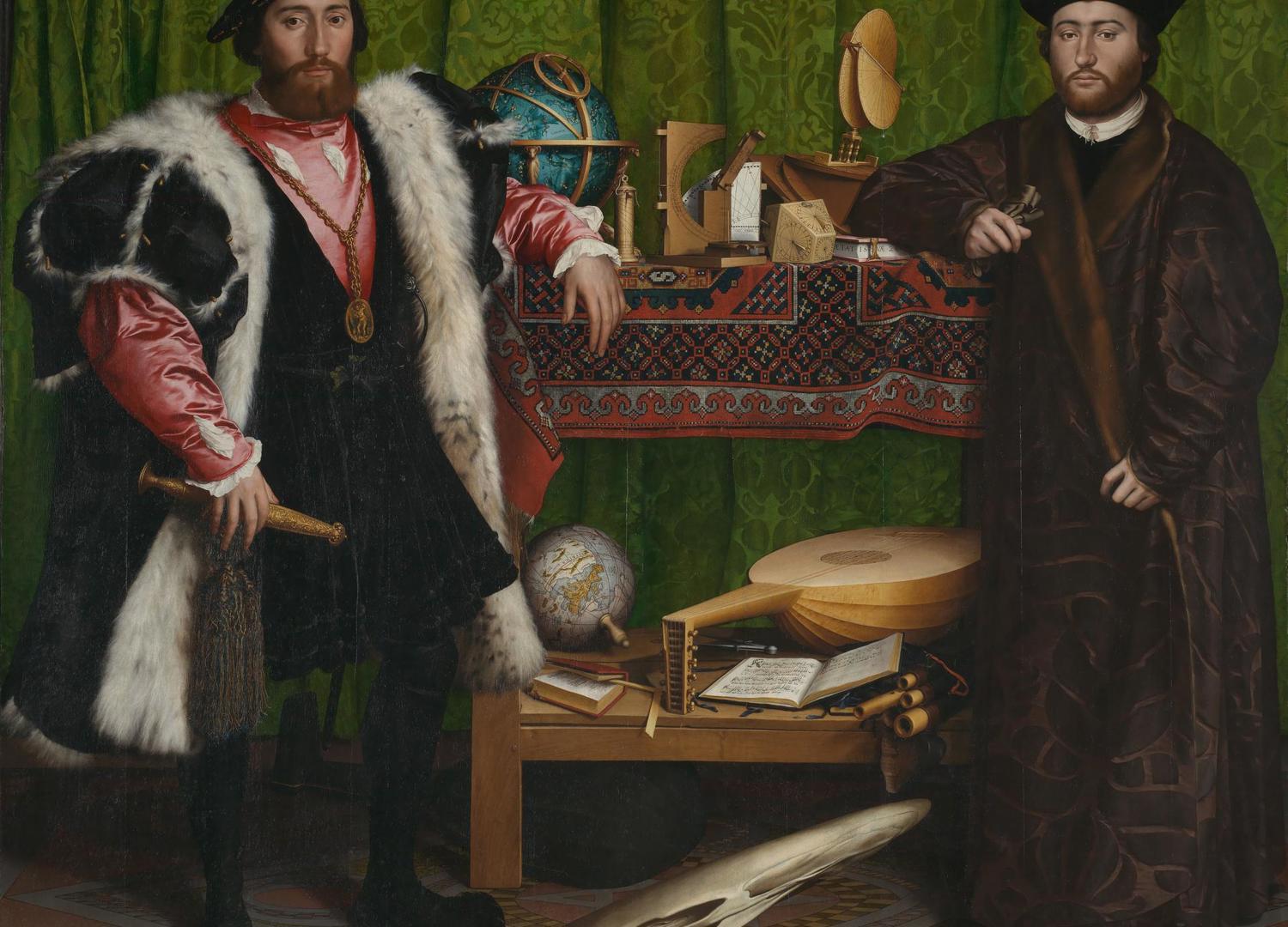5 March 2020 onwards
The National Portrait Gallery’s famous Henry VIII cartoon by Hans Holbein the Younger, is now on display for the first time in over twenty years next to the painting that partly inspired it, Holbein’s The Ambassadors, at the National Gallery.
One of the National Portrait Gallery’s most treasured works, this fragment of a preparatory drawing for a now lost painting, has very rarely been loaned since it was acquired by the gallery in 1957.
The portrait is the first in a series of works to be displayed at the National Gallery as part of the National Portrait Gallery’s major programme of activities, supported by Art Fund, which will see hundreds of works from the gallery’s collection shared across the UK when work begins on 'Inspiring People', the gallery’s biggest ever redevelopment, in July 2020.
Other portraits to be loaned to the National Gallery include Sir Antony van Dyck’s self portrait, of about 1640; 'The Sharp Family', 1799-1781 by Johan Joseph Zoffany (on long-term loan to the National Portrait Gallery); 'John Playfair', 1811, by Sir Henry Raeburn and Gwen John’s self portrait, of about 1900.
The Holbein cartoon, which shows both Henry VIII and his father Henry VII, is the only remaining fragment of a spectacular life-size preparatory drawing of a lost painted group portrait of members of the Tudor royal family.
Destroyed when the royal palace of Whitehall burnt down in 1698, the painting from 1537 (recorded in a small painted copy) featured life-size portraits of Henry VIII, his third wife Jane Seymour (who had just died after giving birth to his long-awaited male heir, the future Edward VI), and his parents Henry VII and Elizabeth of York.
The composition of this destroyed painting was inspired by Holbein’s 1533 portrait of two French ambassadors to the English court. Now the cartoon and the National Gallery’s The Ambassadors can be seen next to each other.
Instead of the shelves of objects seen in the National Gallery’s portrait of Jean de Dinteville and Georges de Selve, in the Whitehall finished painting Holbein included a tablet praising the achievements of the new Tudor dynasty.
As well as 'The Ambassadors', the cartoon can now be seen alongside two other Holbein paintings from the National Gallery’s Collection - Christina of Denmark, Duchess of Milan (1497/8–1543), which is another life–size portrait, and A Lady with a Squirrel and a Starling (Anne Lovell?) (about 1526–8); and a portrait, on long term loan, of the great Dutch philosopher Erasmus. This free display in Room 2 offers an exceptional opportunity to see five outstanding works by Holbein together.
(from left): Dr Nicholas Cullinan, Director of the National Portrait Gallery and Dr Gabriele Finaldi, Director of The National Gallery between Holbein’s Henry VIII and Henry VI and The Ambassadors. Photo: © The National Gallery, London.
Dr Nicholas Cullinan, Director of the National Portrait Gallery, London, says: ‘We are delighted our renowned Holbein cartoon has gone on display at the National Gallery, where it can be seen in an enlightening new context alongside 'The Ambassadors', which partly inspired it. These two potent images of power and politics are striking examples of the Tudor dynasty and diplomacy. Seen in the flesh and side by side, the parallels are fascinating, while the juxtaposition of preparatory drawing and finished oil painting reveals Holbein’s meticulous process.’
Dr Nicholas Cullinan, Director of the National Portrait Gallery, London, says: ‘We are delighted our renowned Holbein cartoon has gone on display at the National Gallery, where it can be seen in an enlightening new context alongside 'The Ambassadors', which partly inspired it. These two potent images of power and politics are striking examples of the Tudor dynasty and diplomacy. Seen in the flesh and side by side, the parallels are fascinating, while the juxtaposition of preparatory drawing and finished oil painting reveals Holbein’s meticulous process.’
Dr Gabriele Finaldi, Director of the National Gallery, London, says: ‘This exceptional juxtaposition of 'The Ambassadors' and the National Portrait Gallery's cartoon of King Henry VIII with his father, Henry VII, provides a unique opportunity to see how Holbein fashioned portraits of power at the Tudor court. Never in England had propaganda images been elaborated with such compelling force and such sublime artistry. They remain to our modern eyes extraordinarily impressive.’
The works
NPG 4027: King Henry VIII; King Henry VII by Hans Holbein the Younger, ink and watercolour, about 1536-7, 101 1/2 in. x 54 in. (2578 mm x 1372 mm), Accepted in lieu of tax by H.M. Government and allocated to the National Portrait Gallery, 1957
NPG 4027: King Henry VIII; King Henry VII by Hans Holbein the Younger, ink and watercolour, about 1536-7, 101 1/2 in. x 54 in. (2578 mm x 1372 mm), Accepted in lieu of tax by H.M. Government and allocated to the National Portrait Gallery, 1957
To commemorate the strength and triumphs of the Tudor dynasty, Henry VIII commissioned from Holbein a wall-painting for Whitehall Palace; this was completed in 1537. The immediate impetus for the commission may have been the birth or the expectation of the birth of Henry's son Edward, later Edward VI, in October 1537. The mural may have been in Henry's Privy Chamber and therefore have had a select, restricted audience rather than being an image of wider propaganda. This very large drawing is the preparatory drawing or cartoon for the left-hand section of that wall-painting, and shows Henry with his father Henry VII, the founder of the dynasty. The right-hand section showed Henry VIII's third wife Jane Seymour (1509?-37) and his mother Elizabeth of York (1465-1503). Holbein's painting was destroyed in the Whitehall Palace fire of 1698, and the cartoon for the right-hand side section is lost. The appearance of the whole painting is however recorded in a mid-seventeenth century copy by Remegius van Leemput in the Royal Collection. The cartoon is executed in black ink and watercolour on several sheets of paper joined together. The figures and faces of the kings are cut-outs pasted on to the backing paper. The cartoon is exactly the same size as the finished painting and was used to transfer Holbein's design to its intended position on the palace wall. To do this the cartoon was pricked along the main outlines of the composition and then fixed in the intended position on the wall. Chalk or charcoal dust was then brushed into the holes made by pricking, thus transferring the outline to the wall. Holbein could then proceed with filling in his design.
NG1314: Jean de Dinteville and Georges de Selve ('The Ambassadors') by Hans Holbein the Younger, 1533, oil on oak, 207 x 209.5 cm; Bought by the National Gallery, 1890
Jean de Dinteville, the man on the left, is shown on his second diplomatic mission to England on behalf of Francis I, King of France. To the right is his close friend, Georges de Selve, Bishop of Lavaur. This portrait was painted at a time of religious upheaval in Europe. Although the pope had refused to annull Henry VIII, King of England’s marriage to Catherine of Aragon which resulted in a break with the Roman Catholic Church, in 1533 he married Anne Boleyn. The array of objects on the table seem to allude to discord; the arithmetic book, for example, is open at the page concerning mathematical division.
Jean de Dinteville, the man on the left, is shown on his second diplomatic mission to England on behalf of Francis I, King of France. To the right is his close friend, Georges de Selve, Bishop of Lavaur. This portrait was painted at a time of religious upheaval in Europe. Although the pope had refused to annull Henry VIII, King of England’s marriage to Catherine of Aragon which resulted in a break with the Roman Catholic Church, in 1533 he married Anne Boleyn. The array of objects on the table seem to allude to discord; the arithmetic book, for example, is open at the page concerning mathematical division.
The portrait is a supreme display of Holbein’s skill in composing images and in manipulating oil paint to recreate a variety of textures. If viewed from a particular angle the elongated shape between the men’s feet becomes a skull. Equally hidden at the top left of the picture is a crucifix that hints at the hope of redemption in the resurrected Christ.


